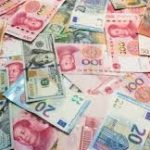 The USD traded sharply lower ahead of Wednesday’s first quarter GDP report and US Fed monetary policy announcement. Consumer confidence also fell to its weakest level in 4 years. Between tomorrow’s 2 big events, GDP should be more market moving than FOMC because the Fed is not expected to change interest rates. GDP will give us the first look at how badly the US economy was hit by COVID-19 and if the contraction was deeper than expected. There was only 2 weeks of full lockdown in Q1 so investors will immediately sell USD on soft data as they fear that the Q2 numbers will be even worse. A contraction of any size would the first since 2011 and as long as GDP falls by more than -1%, it will be the biggest decline in 11 years. If GDP growth falls less than expected because the data only incorporated 2 weeks of economic shutdown, USD could bounce but the rally will be short-lived as investors downplay the data and turn their focus to the Fed.
The USD traded sharply lower ahead of Wednesday’s first quarter GDP report and US Fed monetary policy announcement. Consumer confidence also fell to its weakest level in 4 years. Between tomorrow’s 2 big events, GDP should be more market moving than FOMC because the Fed is not expected to change interest rates. GDP will give us the first look at how badly the US economy was hit by COVID-19 and if the contraction was deeper than expected. There was only 2 weeks of full lockdown in Q1 so investors will immediately sell USD on soft data as they fear that the Q2 numbers will be even worse. A contraction of any size would the first since 2011 and as long as GDP falls by more than -1%, it will be the biggest decline in 11 years. If GDP growth falls less than expected because the data only incorporated 2 weeks of economic shutdown, USD could bounce but the rally will be short-lived as investors downplay the data and turn their focus to the Fed.
After easing aggressively in March, the Federal Reserve is widely expected to leave interest rates unchanged on Wednesday. Their main goal over the past month has been to stabilize a stock market that was swinging by a thousand points a day and to pump liquidity into the financial system. By those measures, they’ve been very successful but investors are focused on growth. So for this monetary policy announcement, there are 3 main questions for the Fed:
- How long will rates remain low?
- How deep will the contraction be?
- What other steps can the Fed take?
Coming off the heels of Q1 GDP, investors will be keen to see what the Fed expects for the economy this year – how deep could the contraction be, how long will the Fed keep rates near zero and what other steps they could take. There’s no question that the Fed will reiterate its pledge not to raise rates anytime soon. They’ll have to acknowledge that the economy has been hit hard by COVID-19 with second quarter growth likely to be very weak. The question here is whether Powell emphasizes the “strong rebound” that will occur when the economy reopens or the grave uncertainty ahead. If he laces his comments with optimism, USD could rally but if he suggests that the new social distancing measures will lead to a slower recovery, USD/JPY could head below 106. Traders should also look at the Fed’s GDP forecast, their pace of asset purchases and any technical adjustments to the rate for excess reserves. They’ve already been slowing bond buying as market functionality normalized so they could make it formal.
The commodity currencies extended their gains against the greenback which was no surprise considering that Australia and New Zealand are opening up their economy after successfully controlling coronavirus. Both currencies are in focus tonight with New Zealand trade and Australian inflation data scheduled for release. Inflation expectations increased in Australia in the first quarter which should lead to relatively stable CPI. If we are right, this should reinforce the rally in the AUD. New Zealand’s trade surplus is also expected to improve, which should fuel further gains for its currency. USD/CAD dropped below 1.40 for the first time in nearly 2 weeks. Considering that oil prices are lower, this move was driven entirely by USD weakness.
Euro which had come close to 1.09 at the start of the NY session came off earlier highs. Analysts expect EUR to underperform ahead of EZ GDP and ECB. German inflation and Eurozone confidence numbers are scheduled for release tomorrow – softer data is expected all around. Sterling ended the day up slightly stronger versus the greenback despite weaker CBI distributive trades.